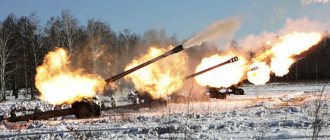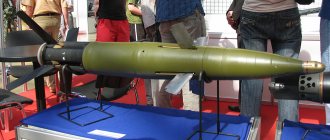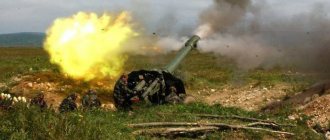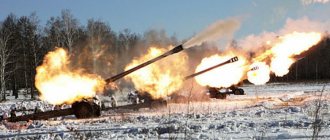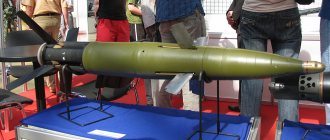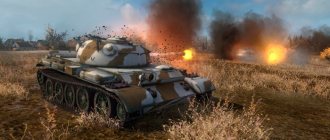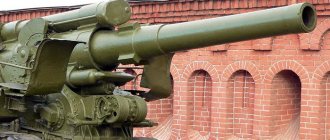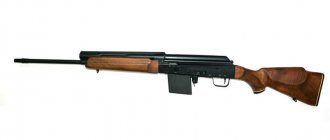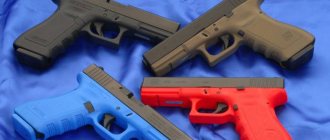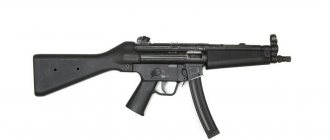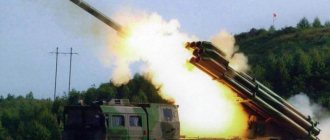Towed howitzer D-30 - video
The D-30 howitzer consists of a barrel, recoil devices, a carriage and sighting devices. The howitzer barrel consists of a pipe, a double-slit muzzle brake, grips, a breech and a bolt. Barrel length is approximately 38 calibers. The method of loading the gun is manual, separate-case. Recoil devices consist of a retractor and a recoil brake. The carriage consists of a cradle, an upper machine, a lower machine, a balancing mechanism, drives for vertical and horizontal aiming, wheel travel, suspension mechanisms, and a mechanism for attaching the gun in a traveling manner. The design of the howitzer carriage ensures all-round firing at barrel elevation angles from −5° to +18° and firing at elevation angles from −7° to +70°, when the breech is located in sectors between adjacent frames.
Sighting devices consist of a panoramic sight and a telescopic sight. The barrel, cradle, recoil devices and sighting devices make up the swinging part of the gun, which is driven into rotation relative to the axis of the barrel cradle trunnions when aiming the barrel in a vertical plane. The swinging part, the upper machine with a combat shield and wheel travel, which balances the mechanism and the aiming drive, form a rotating part, which is driven into rotational motion relative to the axis of the combat pin of the upper machine when aiming the barrel in the horizontal plane. The lower machine with three frames and a hydraulic jack form the part of the gun that is stationary when aiming the barrel.
The use of a new layout made it possible to significantly improve the characteristics of the gun compared to its predecessor: the barrel elevation angle increased from 63.5 to 70 degrees, and the maximum firing range increased from 11.8 to 15.3 km. All this, combined with a projectile weighing 21.7 kg, makes it easy to destroy hidden enemy targets. A semi-automatic wedge bolt facilitated the work of the crew and made it possible to increase the rate of fire to 8 rounds per minute - versus 6 shots for its predecessor, which had a piston bolt. The new barrel layout, with the recoil brake and knurler located on top, made it possible to reduce the height of the firing line from 1200 to 900 mm. All this reduced the height of the gun and made it easier to camouflage on the battlefield.
High-explosive fragmentation shells of increased power 3OF56 are used to fire from the 122-mm D-30 howitzer. It is possible to use other types of ammunition - anti-tank cumulative, smoke, lighting, as well as propaganda with leaflets. Special extended-range projectiles were also developed for the D-30, including high-explosive fragmentation ERFBs produced in Croatia, which allow a maximum firing range of 17,630 m. The use of active-rocket projectiles allows the firing range to be increased to 21,900 meters. The D-30's ability to deliver a high-explosive fragmentation projectile weighing 21.76 kg at a range of more than 15,000 m is excellent performance for a 122-mm howitzer weighing just over 3,000 kg.
The D-30 howitzer uses torsion bar suspension on the wheel arms. When hitting obstacles, the wheel arms turn, twisting the torsion bars. Thanks to the elasticity of the steel, the torsion bar begins to unwind and, like a spring, returns the lever to its previous position.
The method of transporting the weapon is very unusual. All three frames are interconnected and suspended from the trunk. The gun is pulled by the barrel using a pin device attached to the muzzle. The use of torsion bar suspension made it possible to transport the gun at high speed - the highest permissible speed on good roads with asphalt or concrete surface is up to 80 km/h. The howitzer is also equipped with a ski rig for transportation in deep snow. Shooting from a ski rig is not possible. The comparative compactness of the howitzer even made it possible to carry it out from the air - special platforms were provided for this.
The D-30 howitzer became one of the most common artillery systems in the armies of the Warsaw Pact member states; in addition, it was widely exported and licensed in several countries. In the units and subunits that were armed with the D-30, it was valued primarily for its high reliability, ease of maintenance and high fire performance. Currently, its production in the CIS countries has been discontinued.
Modifications of the D-30 were produced in China, the former Yugoslavia, Egypt, Iran, and Iraq. After a relative improvement in relations with the USSR, the D-30 began to be produced in Yugoslavia on the basis of a Soviet license. Here it received the name D-30Yu. The maximum firing range is specified as 17,500 meters. In Iraq, the D-30 was produced under the designation "Saddam", but its production depended on imported components. It has been and is being used in many military conflicts. The D-30's serious baptism of fire took place during the war in Afghanistan, where the howitzer was used very actively and proved itself well.
Based on the gun, a 122-mm self-propelled howitzer 2S1 “Gvozdika” was created, which gave the D-30 greater mobility and security. Another Soviet self-propelled gun with the D-30 “on board” was the 122-mm self-propelled gun 2S2 “Violet”. The BMD-1 was used as its chassis.
In the USSR, one tank division had 36 D-30 systems (a regiment of two divisions had 18 guns each with three batteries of six guns each), and a motorized rifle division had 72 (each motorized rifle regiment had one division (18 guns), and an artillery regiment had two divisions). Subsequently, the number of guns in the battery increased to eight, and in each division to 24.
122-mm self-propelled howitzer 2S1 “GVOZDIKA”
Floating self-propelled gun 2C1 “Gvozdika”
The development of the 2S1 Gvozdika self-propelled gun was started according to Decree No. 609-201 of July 4, 1967. The artillery unit was developed at OKB-9 (Uralmash), and the chassis was developed at the Kharkov Tractor Plant.
The artillery part of the self-propelled guns was developed on the basis of the 122 mm towed howitzer D-30. The internal structure of the barrel, ballistics and ammunition are the same as the D-30. The new howitzer received the factory index D-32 and the GRAU index - 2A31.
The barrel of the D-32 howitzer consisted of a monoblock pipe, a breech, a coupling, an ejection device and a double-chamber muzzle brake. Vertical wedge shutter with semi-automatic mechanical (copier) type. The lifting mechanism was sectoral and had only a manual drive.
The recoil brake is hydraulic spindle type, the knurl is pneumatic. The recoil and retractor brake cylinders are fixed in the breech and roll back along with the barrel.
The barrel is balanced by a push-type pneumatic balancing mechanism.
The ramming mechanism is of an electromechanical type, designed for separate loading of a projectile and a loaded cartridge case into the barrel chamber after placing them on the rammer tray.
The PG-2 periscope sight (index 10P40) is designed both for firing from closed positions and for direct fire. PG-2 consists of a panorama, a mechanical sight with a matching unit, an OP5-37 direct-fire optical sight, a parallelogram drive and an electrical unit.
The SAC 2S1 chassis was developed on the basis of the MT-LB.
In the self-propelled gun, the control compartment and engine-transmission compartments are located in the front part of the hull, and the fighting compartment is located in the middle and aft parts of the hull, as well as in the turret.
The armor of the self-propelled gun is bulletproof; it must “hold” a 7.62 mm rifle bullet at a distance of 300 m.
The transmission of the self-propelled gun is mechanical, the suspension is torsion bar. The tracks have rubber-metal joints.
1* In 1969, OKB-9 developed a project for installing the Aktiya, Gvozdika and Tulip products on a single unified chassis based on the BMP-1, where the products could have better characteristics than those created on the MT-LB basis and about. 123.
Scheme of self-propelled gun 2S1 “Gvozdika.”
Howitzer D-32 caliber 122 mm
SAU 2C1
The 2S1 self-propelled gun has a hermetic body and overcomes water obstacles by swimming. When afloat, the track tracks act as blades. The caterpillars rewind in the water, thanks to which the speed of movement afloat reaches 4.5 km/h.
The Gvozdika self-propelled gun can be transported by An-12 aircraft.
The first four 2S1 prototypes were submitted for field testing in August 1969. The 2S1 was adopted for service in 1971, and mass production began in 1972.
Shooting modes:
Sighting rate of fire when firing directly, rds/min. 4-5
Sighting rate of fire when firing from closed positions:
when firing shots from the ground without re-packing the charges, rds/min. 4-5
when using shots from an ammunition rack and at different elevation angles, rds/min. 1.5-2
The transportable ammunition of the 2S1 self-propelled gun is usually 35 high-explosive fragmentation and 5 cumulative shells. The self-propelled howitzer can fire all types of ammunition from the D-30 towed howitzer.
The BP-1 cumulative rotating projectile is fired with a special Zh-8 charge weighing 3.1 kg; initial speed 740 m/s; table range 2000 m.
Normal armor penetration is 180 mm; at an angle of 60° - 150 mm, at an angle of 30° - 80 mm, armor penetration does not depend on distance.
The initial speed of the 35K-13 cumulative projectile is 726 m/s.
The Sh1 projectile with arrow-shaped striking elements is interesting.
It is designed for the M-30, but can also be fired from the D-32. The arrow-shaped elements fly out in a cone with an angle of 24°. Shots of howitzer D-30 Name
| Projectile index | Projectile weight, kg | Explosive weight, kg | Fuzes | Notes | |
| High explosive | OF-462 OF-426ZH OF-7 OF-8 | 21,7 | 3,67 • • • | RGM, V-90 | • |
| 21,7 • • | • • • | ||||
| Cumulative | ZBK-13 BP-1 ZBK-6 | 18,2 | • • • | • | rotating non-rotating |
| 14,08 | GKN, GPV-Z | ||||
| • | GT1V-2 | ||||
| Smoke | D4 | 21,76 | —; | RGM | |
| Chemical | KhSO-463B | 21,7 | substance R-35 | RGM-2 | |
| Lighting | S-463 | 22,0 | . .; | T-7 | Parachute, burn time 30 seconds. |
| Propaganda | A1D | 21,5 | T-7 | ||
| Projectile with arrow-shaped elements | Ш1 | 21,76 | 2,075 | DTM-75 | _ |
Table of firing shells OF-462, OF-462ZH, OF24, OF-24ZH, D4, D4M
| Charge type | Full | Decreased | № 1 | № 2 | № 3 | № 4 |
| Charge weight, kg | 3,8 | • | • | • | • | • |
| Initial speed, m/s | 690 | 565 | 463 | 417 | 335 | 276 |
| Range, m | 15300 | 12800 | 11600 | 9800 | 8400 | 6400 |
Notes:
122-mm self-propelled howitzer 2S1 “GVOZDIKA”
Floating self-propelled gun 2C1 “Gvozdika”
The development of the 2S1 Gvozdika self-propelled gun was started according to Decree No. 609-201 of July 4, 1967. The artillery unit was developed at OKB-9 (Uralmash), and the chassis was developed at the Kharkov Tractor Plant.
The artillery part of the self-propelled guns was developed on the basis of the 122 mm towed howitzer D-30. The internal structure of the barrel, ballistics and ammunition are the same as the D-30. The new howitzer received the factory index D-32 and the GRAU index - 2A31.
The barrel of the D-32 howitzer consisted of a monoblock pipe, a breech, a coupling, an ejection device and a double-chamber muzzle brake. Vertical wedge shutter with semi-automatic mechanical (copier) type. The lifting mechanism was sectoral and had only a manual drive.
The recoil brake is hydraulic spindle type, the knurl is pneumatic. The recoil and retractor brake cylinders are fixed in the breech and roll back along with the barrel.
The barrel is balanced by a push-type pneumatic balancing mechanism.
The ramming mechanism is of an electromechanical type, designed for separate loading of a projectile and a loaded cartridge case into the barrel chamber after placing them on the rammer tray.
The PG-2 periscope sight (index 10P40) is designed both for firing from closed positions and for direct fire. PG-2 consists of a panorama, a mechanical sight with a matching unit, an OP5-37 direct-fire optical sight, a parallelogram drive and an electrical unit.
The SAC 2S1 chassis was developed on the basis of the MT-LB.
In the self-propelled gun, the control compartment and engine-transmission compartments are located in the front part of the hull, and the fighting compartment is located in the middle and aft parts of the hull, as well as in the turret.
The armor of the self-propelled gun is bulletproof; it must “hold” a 7.62 mm rifle bullet at a distance of 300 m.
The transmission of the self-propelled gun is mechanical, the suspension is torsion bar. The tracks have rubber-metal joints.
1* In 1969, OKB-9 developed a project for installing the Aktiya, Gvozdika and Tulip products on a single unified chassis based on the BMP-1, where the products could have better characteristics than those created on the MT-LB basis and about. 123.
Scheme of self-propelled gun 2S1 “Gvozdika.”
Howitzer D-32 caliber 122 mm
SAU 2C1
The 2S1 self-propelled gun has a hermetic body and overcomes water obstacles by swimming. When afloat, the track tracks act as blades. The caterpillars rewind in the water, thanks to which the speed of movement afloat reaches 4.5 km/h.
The Gvozdika self-propelled gun can be transported by An-12 aircraft.
The first four 2S1 prototypes were submitted for field testing in August 1969. The 2S1 was adopted for service in 1971, and mass production began in 1972.
Shooting modes:
Sighting rate of fire when firing directly, rds/min. 4-5
Sighting rate of fire when firing from closed positions:
when firing shots from the ground without re-packing the charges, rds/min. 4-5
when using shots from an ammunition rack and at different elevation angles, rds/min. 1.5-2
The transportable ammunition of the 2S1 self-propelled gun is usually 35 high-explosive fragmentation and 5 cumulative shells. The self-propelled howitzer can fire all types of ammunition from the D-30 towed howitzer.
The BP-1 cumulative rotating projectile is fired with a special Zh-8 charge weighing 3.1 kg; initial speed 740 m/s; table range 2000 m.
Normal armor penetration is 180 mm; at an angle of 60° - 150 mm, at an angle of 30° - 80 mm, armor penetration does not depend on distance.
The initial speed of the 35K-13 cumulative projectile is 726 m/s.
The Sh1 projectile with arrow-shaped striking elements is interesting.
It is designed for the M-30, but can also be fired from the D-32. The arrow-shaped elements fly out in a cone with an angle of 24°. Shots from a D-30 howitzer
| Name | Projectile index | Projectile weight, kg | Explosive weight, kg | Fuzes | Notes |
| High explosive | OF-462 OF-426ZH OF-7 OF-8 | 21,7 | 3,67 • • • | RGM, V-90 | • |
| 21,7 • • | • • • | ||||
| Cumulative | ZBK-13 BP-1 ZBK-6 | 18,2 | • • • | • | rotating non-rotating |
| 14,08 | GKN, GPV-Z | ||||
| • | GT1V-2 | ||||
| Smoke | D4 | 21,76 | —; | RGM | |
| Chemical | KhSO-463B | 21,7 | substance R-35 | RGM-2 | |
| Lighting | S-463 | 22,0 | . .; | T-7 | Parachute, burn time 30 seconds. |
| Propaganda | A1D | 21,5 | T-7 | ||
| Projectile with arrow-shaped elements | Ш1 | 21,76 | 2,075 | DTM-75 | _ |
Table of firing shells OF-462, OF-462ZH, OF24, OF-24ZH, D4, D4M
| Charge type | Full | Decreased | № 1 | № 2 | № 3 | № 4 |
| Charge weight, kg | 3,8 | • | • | • | • | • |
| Initial speed, m/s | 690 | 565 | 463 | 417 | 335 | 276 |
| Range, m | 15300 | 12800 | 11600 | 9800 | 8400 | 6400 |
Table of contents
Modifications of the D-30 howitzer
D-30 - on the first releases there is a mechanical jack for hanging wheels with two handles for two calculation numbers, the jack base plate is round, on later releases the jack is replaced with a more advanced one - hydraulic, controlled by one calculation number, the jack base plate is rectangular, the tires are filled with rubber harnesses, as a result of which the maximum towing speed is limited to 40 km/h.
D-30A (2A18M) - a two-chamber muzzle brake instead of a slot brake, more developed rectangular combined brake lights and side lights protruding above the gun shield, pneumatic tires that allow towing at speeds of more than 40 km/h;
2A18M-1 - added rammer;
D-30J - Yugoslav modification;
"Saddam" - Iraqi modification;
Type-96 - Chinese version;
"Khalifa" - Sudanese version;
Semser is an Israeli modification of the self-propelled guns, representing the D-30 on the KAMAZ-63502 chassis for the Armed Forces of Kazakhstan.
"Khalifa-1" - a Sudanese modification of the self-propelled guns, representing the D-30 on the KAMAZ-43118 chassis
Tactical and technical characteristics of the D-30A howitzer
— Entered into service: 1963 - Manufacturer: Plant No. 9, PMZ (2A18 for SAO 2S1)
Calculation: 6 people
Projectile speed D-30A
— Initial speed of a high-explosive fragmentation projectile (full charge): 690 m/s — Initial speed of a high-explosive fragmentation projectile (reduced variable charge): 270–565 m/s — Initial speed of a cumulative projectile: 740 m/s
— Maximum pressure of powder gases: 250 MPa — Weight of high-explosive fragmentation projectile: 21.76 kg — Weight of cumulative projectile: 14 kg — Weight of charge (full): 4 kg
Firing range of D-30A
— Longest firing range: 15.4 km
Overall dimensions D-30A
— Barrel length with muzzle brake (without pivot beam): 4.66 m (38klb) — Barrel length without muzzle brake: 4.3 m (35klb) — Length of the rifled part: 3.4 m — Howitzer length in stowed position: 5 .4 m — Width of the howitzer in the stowed position: 2.2 m — Height of the howitzer in the stowed position (excluding lights): 1.8 m — Height of the line of fire: 0.9 m — Length of the howitzer in the firing position at an elevation angle of 0° : 7.8 m — Distance between the support points of the carriage in the firing position: 5.6 m — Ground clearance (minimum): 0.325 m
— Number of rifling: 36 — Highest elevation angle: 70° — Lowest declination angle: −7° — Horizontal firing at a barrel elevation angle from −5° to 18°: 360° — Horizontal firing at an elevation angle from +18° to 70° and when the barrel is positioned between the movable frames: 66° - Horizontal fire at an elevation angle from +18° to 70° and when the barrel is positioned between the fixed and movable frames: ±29° - The amount of Steol M liquid in the brake of the recoil parts: 10, 3 l - Amount of Steol M liquid in the knurl: 9.7 l - Amount of Steol M liquid in the balancing mechanism: 0.45 l - Initial pressure in the knurl: 4.6 MPa - Normal rollback length: 0.74-0.93 m — Pressure in the balancing mechanism: 6MPa
Weight D-30A
— Howitzer in combat position: 3200 kg. — Howitzer in traveling position: 3290 kg. — Barrel: 1.05 t — Shutter: 30 kg — Swinging part: 1.5 t — Recoiling part: 1.23 t — Cradle: 210 kg — Brake of recoil parts assembled: 75 kg — Upper machine: 212 kg — Lower machine with fixed bed: 318 kg - Beds (two): 310 kg - Knurl assembled: 73 kg - Wheels with hub: 148 kg - Ski rig: 270 kg
Rate of fire D-30A
— Howitzer rate of fire: 6-8 rounds/min — Time to transfer from traveling to combat position: 1.5-2.5 min
— Highest transportation speed: 80 km/h
Howitzer device
The howitzer consists of a barrel, recoil devices, a carriage and sighting devices. The barrel is made of a pipe, a muzzle brake, grips, a breech and a wedge bolt with a vertical stroke. Recoil devices consist of a hydropneumatic knurl (46 atm) and a hydraulic brake of the recoil parts. The carriage consists of a cradle, an upper machine, a lower machine, a balancing mechanism, drives for vertical and horizontal aiming, wheel travel, suspension mechanisms, and a mechanism for attaching the gun in a traveling manner. Sighting devices consist of a PG-1 panoramic sight and an OP-4M telescopic sight. The barrel, cradle, recoil devices and sighting devices make up the swinging part of the gun, which is driven into rotation relative to the axis of the barrel cradle trunnions when aiming the barrel in a vertical plane. The pumping part, the upper machine with a combat shield and wheel travel, the balancing mechanism and the aiming drive form a rotating part, which is driven into rotational motion relative to the axis of the combat pin of the upper machine when aiming the barrel in the horizontal plane. The lower machine with three frames and a hydraulic jack (in an early modification, a mechanical jack) form a part of the gun that is stationary when aiming the barrel. The jack is used to lift the howitzer for deployment and bringing the frames from the traveling position to the combat position and back.
